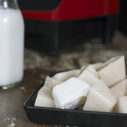… Yay, Dairy-Free Buttermilk!
When going dairy-free, and gluten-free for that matter, there are so many foods that seem to be put on the back burner … out of the kitchen completely actually. With a shrug, and perhaps a few choice words, we do so because we know that our health is a priority.
After the haste has passed and we take a moment to re-evaluate the actual situation at hand, we come to find out that some of our favorite ingredients are not necessarily “out of the question”, but simply need altering or looking at with new eyes.
Naturally gluten-free, dairy-free buttermilk is a perfect example of this scenario. While I didn’t rely heavily on buttermilk for cooking before my dairy days became non-existent, it is a cooking basic that has a definitive role to play in recipes such as buttermilk biscuits, fluffy pancakes, waffles with a special tang, crispy oven-fried chicken, ranch dressing, ice cream, and … well, you get the idea … Buttermilk is still a need-to-have item in our dairy-free kitchens. It is a perfect solution (no pun intended, but true) in the vegan kitchen as well.
Thankfully, creating our own dairy-free buttermilk at home is extremely simple and requires only two ingredients, both which I’m pretty sure you have on hand at all times. You simply need non-dairy milk such as almond, cashew, coconut, hemp, or rice milk (though rice milk will have a more watering consistency than standard buttermilk). The second ingredient is an acid. My choices are either lemon juice or vinegar (rice, white, or apple cider).
To write a recipe is more work than necessary. Simply put, to create one cup of buttermilk, use one of cup non-dairy milk minus 1 Tablespoon. Replace that missing Tablespoon with one Tablespoon of vinegar or lemon juice, to again equal 1 cup. To increase or decrease your quantity, simply use one teaspoon of acid per 1/3 cup milk substitute. Here’s a quick equation:
1 cup dairy-free buttermilk = 1 cup (minus 1 Tablespoon) dairy-free milk + 1 Tablespoon acid.
When your recipe calls for buttermilk, simply create this mixture, stir, and allow to sit for 5-10 minutes. Stir again and add to recipe as directed.
While some people might desire purchasing a readily-available non-dairy buttermilk, I would still prefer to make a homemade buttermilk version. There’s no question as to whether it contains other ingredients such as soy, preservatives, etc., and by making it at home, the quantity is always correct and the “product” is fresh.
Happy Buttermilk Baking!
Safe food is a journey … Thrive!™
Other recipes you might enjoy:




